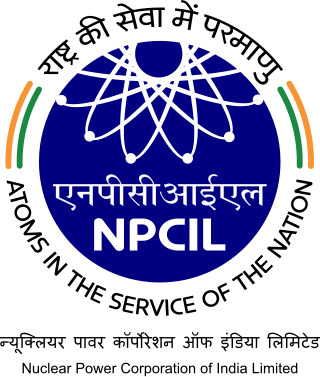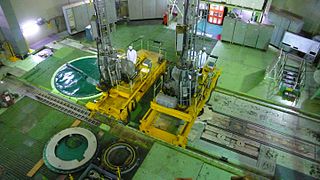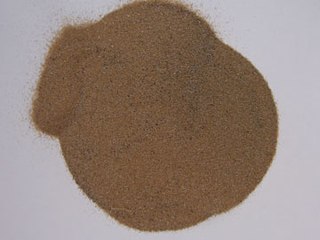
The Bhabha Atomic Research Centre (BARC) is India's premier nuclear research facility, headquartered in Trombay, Mumbai, Maharashtra, India. It was founded by Homi Jehangir Bhabha as the Atomic Energy Establishment, Trombay (AEET) in January 1954 as a multidisciplinary research program essential for India's nuclear program. It operates under the Department of Atomic Energy (DAE), which is directly overseen by the Prime Minister of India.

The Nuclear Power Corporation of India Limited (NPCIL) is an Indian public sector undertaking based in Mumbai, Maharashtra. It is wholly owned by the Government of India and is responsible for the generation of electricity from nuclear power. NPCIL is administered by the Department of Atomic Energy (DAE).

Kaiga Generating Station is a nuclear power generating station situated at Kaiga, near the river Kali, in Uttara Kannada district of Karnataka, India. The plant has been in operation since March 2000 and is operated by the Nuclear Power Corporation of India.

Madras Atomic Power Station (MAPS) located at Kalpakkam about 80 kilometres (50 mi) south of Chennai, India, is a comprehensive nuclear power production, fuel reprocessing, and waste treatment facility that includes plutonium fuel fabrication for fast breeder reactors (FBRs). It is also India's first fully indigenously constructed nuclear power station, with two units each generating 220 MW of electricity. The first and second units of the station went critical in 1983 and 1985, respectively. The station has reactors housed in a reactor building with double shell containment improving protection also in the case of a loss-of-coolant accident. An Interim Storage Facility (ISF) is also located in Kalpakkam.

Rawatbhata is a city, Tehsil, Sub District and Nagar Palika in Chittorgarh District, Rajasthan, India. Rawatbhata is a Proposed District, It is 131 km from Chittorgarh city, 50 km from the nearest city, Kota. The city has eight nuclear power stations, a nuclear fuel complex and a heavy water plant. Rawatbhata also has the biggest dam of Rajasthan, Rana Pratap Sagar Dam, which is built on the Chambal River. The dam is equipped with a 172 MW hydroelectric power station.

Tarapur Atomic Power Station (T.A.P.S.) is located in Tarapur, Palghar, India. It was the first commercial nuclear power station built in India.

Kudankulam Nuclear Power Plant is the largest nuclear power station in India, situated in Kudankulam in the Tirunelveli district of the southern Indian state of Tamil Nadu. Construction on the plant began on 31 March 2002, but faced several delays due to opposition from local fishermen. KKNPP is scheduled to have six VVER-1000 reactors built in collaboration with Atomstroyexport, the Russian state company and Nuclear Power Corporation of India Limited (NPCIL), with an installed capacity of 6,000 MW of electricity.

Kakrapar Atomic Power Station is a nuclear power station in India, which lies in the proximity of Mandvi, Surat and Tapi river in the state of Gujarat.
Nuclear power is the fifth-largest source of electricity in India after coal, gas, hydroelectricity and wind power. As of November 2020, India has 23 nuclear reactors in operation in 8 nuclear power plants, with a total installed capacity of 7,380 MW. Nuclear power produced a total of 43 TWh in 2020–21, contributing 3.11% of total power generation in India. 10 more reactors are under construction with a combined generation capacity of 8,000 MW.

India's three-stage nuclear power programme was formulated by Homi Bhabha, the well-known physicist, in the 1950s to secure the country's long term energy independence, through the use of uranium and thorium reserves found in the monazite sands of coastal regions of South India. The ultimate focus of the programme is on enabling the thorium reserves of India to be utilised in meeting the country's energy requirements. Thorium is particularly attractive for India, as India has only around 1–2% of the global uranium reserves, but one of the largest shares of global thorium reserves at about 25% of the world's known thorium reserves. However, thorium is more difficult to use than uranium as a fuel because it requires breeding, and global uranium prices remain low enough that breeding is not cost effective.

Narora Atomic Power Station (NAPS) is a nuclear power plant located in Narora, Dibai Tehsil, Bulandshahar District in Uttar Pradesh, India.

The Gorakhpur Nuclear Power Plant or the Gorakhpur Haryana Anu Vidyut Pariyojana (GHAVP) is a proposed nuclear power plant to be built on a 560 hectares area west of Gorakhpur village of Fatehabad district of Haryana.
The Chutka Nuclear Power Plant is a proposed nuclear power plant to be built on a 1,200 acres (490 ha) area, near Chutka Village of Mandla district of Madhya Pradesh. The site is near Kanha National Park, one of the tiger reserves of India and the largest national park of Madhya Pradesh state in India.

The IPHWR-700 is an Indian pressurized heavy-water reactor designed by the NPCIL. It is a Generation III reactor developed from earlier CANDU based 220 MW and 540 MW designs. It can generate 700 MW of electricity. Currently there is two unit operational, 6 units under construction and 8 more units planned, at a cost of ₹1.05 lakh crore (US$13 billion).

The IPHWR-220 is an Indian pressurized heavy-water reactor designed by the Bhabha Atomic Research Centre. It is a Generation II reactor developed from earlier CANDU based RAPS-1 and RAPS-2 reactors built at Rawatbhata, Rajasthan. It can generate 220 MW of electricity. Currently, there are 14 units operational at various locations in India. It is sometimes referred to as an small modular reactor due to its modularization.

The IPHWR is a class of Indian pressurized heavy-water reactors designed by the Bhabha Atomic Research Centre. The baseline 220 MWe design was developed from the CANDU based RAPS-1 and RAPS-2 reactors built at Rawatbhata, Rajasthan. Later the design was based on VVER technology which was scaled to 540 MW and 700 MW designs. Currently there are 17 units of various types operational at various locations in India.
The Indian Pressurized Water Reactor-900 (IPWR-900) is a class of pressurized water reactors being designed by the Bhabha Atomic Research Centre (BARC) in partnership with the Nuclear Power Corporation of India Limited to supplement the Indian three-stage nuclear power programme.
The Mahi Banswara Rajasthan Atomic Power Plant (MBRAPP) is a proposed nuclear power plant to be built on a 1,366.49 acres (553.00 ha) area, near Banswara district of Rajasthan.













